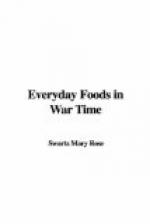Milk will take the place of meat. The world is facing a meat famine. The famine was on the way before the war began but it has approached with tremendous speed this last year. Every cow killed and eaten means not only so much less meat available but so much less of an adequate substitute. Lean meat contributes to the diet chiefly protein and iron. We eat it primarily for the protein. Hence in comparing meat and milk we think first of their protein content. One and one-fourth cups of milk will supply as much protein as two ounces of lean beef. The protein of milk is largely the part which makes cottage cheese. So cottage cheese is a good meat substitute and a practical way of using part of the skim milk when the cream is taken off for butter. One and one-half ounces of cottage cheese (one-fourth cup) are the protein equivalent of two ounces of lean beef. Skim milk and buttermilk are just as good substitutes for meat as whole milk. Since meat is one of the most expensive items in the food bill, its replacement by milk is a very great financial economy. This is true even if the meat is raised on the farm, as food for cattle is used much more economically in the production of milk than of beef.
Milk is the greatest source of calcium (lime). Lime is one of the components of food that serves two purposes; it is both building material for bones and regulating material for the body as a whole, helping in several important ways to maintain good health. It is essential that everyone have a supply of lime and particularly important that all growing infants, children, and young people have plenty for construction of bones and teeth. There is almost none in meat and bread, none in common fats and sugars, and comparatively few common foods can be taken alone and digested in large enough quantities to insure an adequate supply; whereas a pint of milk (whole, skim, or buttermilk) will guarantee to a grown person a sufficient amount, and a quart a day will provide for the greater needs of growing children. Whatever other foods we have, we cannot afford to leave milk out of the diet because of its lime. Under the most favorable dietary conditions, when the diet is liberal and varied, an adult should have at least half a pint of milk a day and no child should be expected to thrive with less than a pint.
Milk contains a most varied assortment of materials needed in small amounts for the body welfare, partly for constructive and partly for regulating purposes. These are rather irregularly distributed in other kinds of food materials. When eggs, vegetables, and cereals are freely used, we are not likely to suffer any lack; but when war conditions limit the number of foods which we can get, it is well to remember that the more limited the variety of foods in the diet the more important milk becomes.




